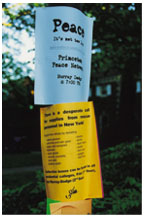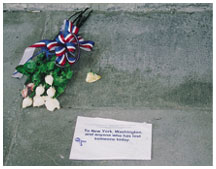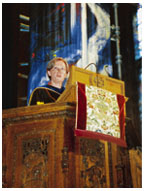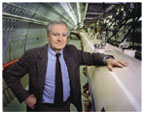October 10, 2001: Notebook



Photos: Students filled Cannon Green at a memorial service on Sunday, September 16, for victims of the disaster. Responses to the attacks included TV viewing in Frist, flowers at Blair Arch, and notices on lampposts.(Photos by Josephine Sittenfeld ’02)
In an instant on the morning of September 11, as students went about the business of the new year — signing up for classes and meeting with advisers — the world changed. As news of the terrorism in New York and Wash-ington, D.C., spread via word-of-mouth, e-mail, and cell phone, members of the university community flocked to computers to get the latest news from the Internet and gathered in Frist Campus Center to watch the unfolding events on one of several large-screen TVs.
Almost immediately upon learning of the disaster, various offices of the university reacted. Counseling services were made available, prayers were offered in the chapel, and President Tilghman issued a statement saying that the university would adhere to its regular schedule to demonstrate that terrorism will not stand in the way of higher education.
“What has transpired today is antithetical to everything we stand for in the academy — respect for others, solving differences through human discourse,” she said. “We will get on with the business of education.”
To help students, faculty,
and staff, the university set up an extensive Web site as well as a one-stop
resource center in Frist to provide information. In addition, a campus-wide
memorial service was held on Sunday, September 16, on Cannon Green. Although
classes went on as planned, many sporting events were delayed, including
Princeton’s opening football game against Lafayette on Saturday,
the 15th. ![]()
Prominent alumni were in the midst of the chaos in Washington. According to the New York Times, Secretary of Defense Donald Rumsfeld ’54 was in his office on the third floor of the outer ring of the Pentagon when hijacked American Airlines Flight 77 crashed. Rumsfeld, a former wrestler and Navy pilot, rushed to the scene and assisted several injured people before going to the National Military Command Center, which though secure was shrouded in smoke.
In the aftermath of the violence, FBI Director Robert Mueller ’66 was a frequent television presence as he reported on the agency’s efforts to track down leads and identify the people and organizations behind the attacks.
Less well-known alumni reached out to fellow Princetonians via TigerNet. Within hours of the attacks, nearly 100 people had posted messages to the career-networking list offering their homes to anyone stranded, according to list coordinator Terry Wintroub ’69. Alumni also posted messages to princeton-matters regarding each others’ safety, and one alumnus, Scott Rafferty ’76 *79, painstakingly compiled a list of Princetonians with work addresses in the Pentagon and World Trade Center and e-mailed each one.
As of press time, seven alumni had been officially confirmed dead. Christopher D. Mello ’98, who was working for Alta Communications in Boston, was aboard American Airlines Flight 11 when it crashed into the World Trade Center. William E. Caswell *75, a physicist with the U.S. Navy, was a passenger on American Airlines Flight 77, which crashed into the Pentagon. Five alumni were killed in World Trade Center offices: Robert L. Cruikshank ’58, the father of Douglas Cruikshank ’87, was an executive vice president for Carr Futures; Karen J. Klitzman ’84, the sister of Robert Klitzman ’80, was working for e-Speed, a division of Cantor Fitzgerald; Robert G. McIlvaine ’97, who worked in media relations for Merrill Lynch, had been attending a meeting; Joshua A. Rosenthal *81 worked for Fiduciary Trust; and Martin P. “Buff” Wohlforth ’76, son of Bob Wohlforth ’47, was managing director for investment bank Sandler O’Neill. At least five other alumni are reported missing.
Families of some of the victims
are working to establish memorial funds. For more information, please
see the university Web site at web.princeton.edu/sites/September11/memorialgifts.htm.
![]()
Along with memorial and interfaith prayer services that took place on Princeton’s campus on Friday, September 14, several university professors and visiting fellows met to discuss what it meant to be American, in the wake of the terrorist attacks earlier in the week. The panel deliberately convened on the National Day of Mourning, as designated by President Bush.
University of Maryland historian Herman Belz, one of the year-long visiting fellows for Princeton’s James Madison Program in American Ideals and Institutions, set the tone for the symposium with his opening remarks.
“In uniting, there comes strength and power,” Belz said in his brief remarks to the audience of 60 Princeton students and faculty. “America’s nationality is unique because it isn’t religious, ethnic, cultural, or even history-based. Rather, it is a strong attachment of the people to the principles and strength of the government of the United States.”
Belz pointed out that for many countries in the world, most notably some Islamic nations, the idea of nationality remains inextricably tied to religious beliefs. Matthew Berke, a senior fellow at the Faith and Reason Institute in Washington, D.C., echoed Belz’s comments, pointing out that strong ideological disagreements with American nationality often can breed resentment and animosity that are unchecked by necessary tolerance.
“Part of the conflict with the Arab and Western worlds is the adaptation to [each other’s] viewpoints. The Arab world is largely the opposite of the Western, and everywhere they look there is occasion for envy and resentment,” Berke said. “We contribute to their feelings of marginalization.”
Berke stressed that America’s strong nationality often appears menacing to other countries, and he warned of the natural inclination of Americans to assume the best in people despite their resentment of American ideals. Slowness to anger is a virtue that we possess, the professor pointed out, but it can easily become a vice if we react too slowly.
Thomas D’Andrea, a visiting research fellow at Cambridge University and a James Madison fellow, more directly stated a need for retribution.
“We must wield swiftly
the sword of justice,” he said, “but let that sword only be
as terrible as absolutely required – may it be a way leading to justice
amongst differing viewpoints.”![]()
By Patrick Sullivan ’02
Photo: Opening Exercises took place in the Chapel, still under renovation. (Photo by Denise Applewhite)
The Class of 2005 turns out to be one of the most diverse in Princeton’s history and also larger than planned.
Earlier this year, 13,654 students applied for admission, and the university sent “Yes” letters to 1,670. Administrators figured on 1,165 students accepting the offer of admission and were surprised to find 20 more students than they expected joining the Orange and Black, creating a 70.7 percent yield.
The result is, as Dean of Admission Fred Hargadon said at a welcoming meeting in Richardson Auditorium on Saturday, September 8, “1,185 short stories, 20 more short stories than we were supposed to have. Now I don’t want to scare you,” Hargadon continued. “But I’ve told my colleagues that we should expect great things of you.”
And what kinds of kids make up the new class? Hargadon, who is loath to describe the classes he admits in terms of percentages, either by race, by country, or even by state, said in a statement, “The 614 men and 571 women of the Class of 2005 come from 825 secondary schools in 48 states, D.C., Guam, Puerto Rico, and 39 other countries. They’ve achieved national and state recognition in debate and speedskating, in writing and in fencing, in science and in athletics, in music and in karate, in 4-H and ROTC. They’ve held jobs, led organizations of one or another sort, developed software, been published, been named Presidential Scholars and All-Americans, and, in at least one instance, become a licensed acupuncturist.”
Dean of the College Nancy Weiss Malkiel gave a more quantified account in a report to the faculty. “The number of students from minority backgrounds in this fall’s entering class of 2005 totals 343, or 28.9 percent of the class, as compared to 305 last year,” she said.
Malkiel pointed out that Princeton’s improvements in financial aid resulted in 46 percent of the freshmen receiving aid, up from 40 percent last year. She also noted that entering students with family incomes below $46,500 grew from 116 in the Class of 2004 to 130 in the Class of 2005.
Opening Exercises
As members of the Class of 2005 drifted tentatively into the University Chapel for Opening Exercises, on Sunday, September 9, a late summer sun shone through the newly restored stained glass windows on the chapel’s south side, casting colored shadows of red and blue on the gray floor. The students, who were expected to attend the interfaith service, for the most part dressed casually; almost all wore sandals, and many were in shorts, but a few men had collared shirts and some women wore skirts.
 President
Tilghman, whose new presidential robe will be unveiled at her inauguration
in late September, wore a robe that was often used by former secretary
of the university Jeremiah Finch at official convocations during the 1960s
and ’70s. She was ushered up the long central aisle by marshals to
the beat of a surdo drum and the bong of an agogo bell, part of a samba
band that led the way and seemed to signal a new sound and rhythm for
the festivities as well as the new century and the new university leadership.
President
Tilghman, whose new presidential robe will be unveiled at her inauguration
in late September, wore a robe that was often used by former secretary
of the university Jeremiah Finch at official convocations during the 1960s
and ’70s. She was ushered up the long central aisle by marshals to
the beat of a surdo drum and the bong of an agogo bell, part of a samba
band that led the way and seemed to signal a new sound and rhythm for
the festivities as well as the new century and the new university leadership.
In her address, Tilghman emphasized over and over again the importance of learning and discovery. “We intend for you to seek knowledge by understanding how it is generated. Lasting learning is fundamentally an active process. It requires an engaged mind, a curious mind, an open mind, a persistent mind. It means that you don’t take things on faith, but rather question everything. So, as you go about this year, I urge you to keep foremost in your minds two questions: ‘How do you know that?’ and ‘Why?’ If you are asking those questions, you will be taking active charge of your own education,” she urged the students.
Prizewinners
As is the custom at Opening Exercises, student prizewinners were introduced. The Freshman First Honor Prize was shared by André Kurs ’04 and Ruth Tennen ’04. Costin Bontas ’03 received this year’s George Wood Legacy Sophomore Prize, and the George Wood Legacy Junior Prize went to Abbie Liel ’02. The Class of 1939 Princeton Scholar Award was shared by Lillian Pierce ’02 and Scott Vafai ’02.
The Graduate School recognized two students who have demonstrated excellence in their scholarship and give promise of exceptionally distinguished careers. They are: Margaret Usdansky, a fourth-year Ph.D. student in sociology, who was awarded a Harold Dodds Honorific Fellowship; and Emile Praun, a fifth-year doctoral candidate in computer science, who will hold a Wallace Memorial Fellowship in Engineering.
Graduate School
New graduate students include 540 degree candidates and 10 non-degree visiting students. Seventy percent of the new graduate students are enrolled in Ph.D. programs; the rest are in master’s programs. This year the Graduate School sees its first class of 26 students pursuing a master of finance degree, a new two-year program.
In the entering group of graduate students, 44 percent are international students, 36 percent are women, 4 percent are African American, 5 percent are Hispanic, and 24 percent are Asian American.
Overall, the Graduate School anticipates registering a total of 1,965 graduate students for the academic year. Like other top-ranked research institutions, Princeton provides full financial assistance to virtually all research doctoral candidates.
Classes began on Thursday,
September 13. ![]()
By L.O.
Roar
of the Tigers
Readers respond to PAW’s survey
Readers may have noticed some changes to PAW’s look this fall. On the cover, Princeton is back in bold letters near the top of the page, followed by Alumni Weekly, and the PAW logo is slightly smaller. Inside, the section headers are larger, making it easier (we hope) for readers to find and distinguish departments such as Notebook and On the Campus. Class Notes sports a new typeface throughout, revised class secretary numerals and contact information, and a return of the Tiger marking items of particular interest.
This tinkering is due in part to the results of a readership survey conducted last spring that asked 2,500 alumni questions about the design and content of PAW. PAW heard from nearly 500 readers, who said that, well, they love PAW — in a “my country right or wrong” sort of sense, that is. A whopping 88 percent of respondents read all or some of every issue, with an additional 5 percent reporting they read about half the issues. Nonetheless, nearly every respondent also had suggestions for ways to improve PAW.
Not surprisingly, the new design of PAW garnered the most feedback, with a third (27%) liking the changes, a third (35%) feeling neutral, and a third (34%) disliking the look. The logo drew the most fire, with half (49%) saying they disliked it. Judging from the written comments, one of the greatest sources of ire was the reduction of the word Princeton on the cover, a major reason why the school name is now back, front and not quite center.
Only 3 percent of the respondents found the new typeface very difficult to read, but of that group, 20 percent said their greatest difficulty lay in Class Notes, which is why the typeface has been changed. A few respondents were confused about word limits in Class Notes and Memorials, which they thought had been decreased; in fact, the Class Notes columns are still 300 words, as they have been for many years, and Memorials are back at their traditional 200-word length after the editor’s ill-advised and short-lived try at shortening them.
On the editorial side, readers said they are faithful Class Notes followers, with 94 percent always, usually, or sometimes reading them. Readers also enjoy the alumni profiles in Class Notes (82%); Features (80%); On the Campus (79%); and Letters (79%). Respondents said they were most likely to read stories about campus life (58%), followed by Princeton history (46%), alumni profiles (45%), and teaching and research (41%); they didn’t care as much about current students (18%).
Fortunately for PAW’s editors, respondents already think PAW does a decent job covering those topics: 76 percent called PAW’s coverage of alumni excellent or good, followed by teaching and research (67%), campus life (64%), and history (60%).
One of the greatest surprises of the survey results came in the Sports section. Only 37 percent always or usually read the Sports section, and only 28 percent said sports were what they most liked to read about. Many respondents wrote to say, in the words of one, “Cool it on the jocks — they just aren’t very interesting.” From those who do read Sports, “Scores! Scores! Scores!” was the cry. Obviously PAW’s method of reporting scores last year — we did report the outcome of virtually every contest — was indecipherable to those not intimately familiar with PAW’s screwy publication schedule. We’ll try to make the scores clearer this year. And a note about that schedule: PAW goes to press two-and-a-half weeks before its cover date, making most scores, we know, hopelessly out of date. Our only advice: Try the Web.
Speaking of which, PAW needs to lure more readers to PAW Online. Only 20 percent of respondents visit regularly, and 77 percent had never seen the site. Most who had seen the site recently were just surfing (40%), but a heartening 15 percent were following up on a print article in PAW. We’ll continue to run enticing stories and bonus coverage online, and we hope you’ll check it out.
Of all the responses we received,
the nicest one was also the most common: “Thanks for asking.”
To everyone who let us know how PAW could be better, we say, “Thanks
for roaring.” ![]()
By J.C.M.
For the second year in a row, Princeton topped U.S. News and World Report’s college and university ranking. The magazine ranked Princeton first in the “national university-doctoral” category, which includes research universities offering a full range of undergraduate majors plus master’s and Ph.D. programs. While Princeton officials were pleased to be recognized as one of many outstanding universities, they downplayed the significance of the rankings. They stressed that the methodology in the report doesn’t capture the distinctiveness of an institution.
More changes have taken place in the administrative ranks of the university. As of the beginning of the academic year, the Office of Finance and Administration, previously held by Vice President Richard Spies, has been split, and Spies will be leaving at the end of the calendar year. The treasurer of the university, Christopher McCrudden, will take on senior level responsibility for all matters related to finance, reporting directly to the president. Senior level responsibility for administration will be assigned to a new vice president for administration, also reporting directly to the president.
 President
Bush last June named John H. Marburger III ’62 (left) as his science
adviser. Marburger, a physicist who earned his doctorate at Stanford University,
is the director of the Brookhaven National Laboratory. Marburger will
head the White House Office of Science and Technology Policy and will
advise on issues such as global warming, energy policy, and stem-cell
research. Senate confirmation is expected this fall.
President
Bush last June named John H. Marburger III ’62 (left) as his science
adviser. Marburger, a physicist who earned his doctorate at Stanford University,
is the director of the Brookhaven National Laboratory. Marburger will
head the White House Office of Science and Technology Policy and will
advise on issues such as global warming, energy policy, and stem-cell
research. Senate confirmation is expected this fall.
The university’s first cabinet meeting of the year took place September 6, and its agenda was the planning for the implementation of the recommendations of the Wythes Report. Vice President Robert Durkee ’69 said that the topic was broken down into four parts: facilities implications, academic implications, campus life implications, and financial implications. Discussion among the 19 members of the cabinet present was along the lines of a preceptorial, said Durkee. Task forces were formed to press ahead with implementation. The first class with the added enrollment will be the Class of 2009, arriving on campus in the fall of 2005.
Harvard Law School was the beneficiary last spring of a trove of 16th-century law books donated by Henry Ess III ’42, who died last fall. Ess, who earned his law degree at Harvard, had over the years collected the books, which are worth millions of dollars today. His was the largest private collection of such books in the world and included books the Puritans brought to Boston. The new-world legislators relied on the books to develop a rule of law, said one Harvard scholar.
The university this summer sold Dunwalke, its 125-acre estate in Bedminster, New Jersey, for $18 million. The price for Dunwalke, which had been bequeathed to Princeton by the late financier Clarence Dillon in 1979, is thought to be a sales record in the state. The university used the property as an academic retreat and conference center.
In the aftermath of the events
on September 11, Princeton’s Arab Society received at least three
harassing e-mails, an incident that was reported to the local police,
who are investigating. It appears that the e-mails originated outside
the university community. The contents of the messages, which PAW has
seen, are too explicitly racist and vulgar to reprint. ![]()
Body copy goes here. ![]()
